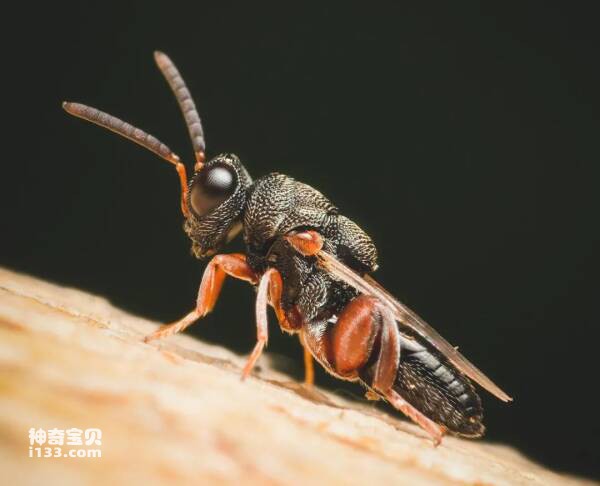In order to test whether cicadas have ears, someone once did an experiment: he set up two earthen cannons under a big tree, and the cicadas were singing love songs in the tree. boom! The cannon fired, and the thunderous sound of the cannon deafened people, but the cicada seemed not to hear it and continued to sing. So he thought the cicada was deaf. In fact, the cicada is not deaf, but its hearing range is different from that of humans. Insect ears are not like human ears. They have various shapes and their positions on the body are not fixed. The simplest ears are just sensory hairs. The structure of this hairy hearing organ is very simple. There is only one nerve cell connected to the follicular membrane inside. When the bristles are bent by air vibration or pressure, the follicular membrane is transmitted to the central nervous system through the nerve cells, and the corresponding response is made. Another type of ear is called the tympanic organ, which has an oval or round tympanic membrane that is slightly concave in the surrounding body wall and a hearing body composed of several sets of tip receptors, which are directly connected to the inner wall of the tympanic membrane, or connected to the eardrum. On the epigenetic membrane connected to the tympanic membrane.

The ability of insects to emit and receive sound signals has long attracted the attention of scientists. As a result, a new method of preventing agricultural pests has been developed - the acoustic prevention method, which uses the characteristics of insects to respond to sound to trap or repel certain insects. Some types of insects have been used to reduce damage, and initial success has been achieved.
1. The ears on the antennae
The auditory hairs of male mosquitoes and ants grow on their antennae, and the most sensitive part of the insect's ear is the Joan's organ. The Joan's organ is located in the antennal peduncle. Most insects use it to control the position and movement of the antennae, but male mosquitoes and The Qiong's organ of black beetles is used as a hearing organ. The Joanna's organ of the male Anopheles mosquito has about 30,000 sensory cells. Its sensitivity is comparable to that of the human ear, and it is most sensitive to low-frequency sound waves of 350-550 cycles seconds.
2. The ears on the chest
The tympanic auditory organ of the backstroke stink bug is located on the thorax, and the tympanic organ of adult Lepidoptera is located on the metathorax or the first abdominal segment. The auditory organ of the noctuid moth is located in the recess between the chest and abdomen, and can actually sense ultrasonic waves. This ability allows the noctuid moth to avoid predators from bats in time. When a bat appears, the ultrasonic waves emitted by the noctuid moth have already notified the noctuid moth, so Noctua hurriedly hid.
3. Ears on the abdomen
The cicada's ears are located near the second segment of the abdomen. They are composed of a relatively thick eardrum and 1,500 sword-tip receptors below. When the sound waves are transmitted to the auditory organ, the signal is then sent to the brain, and the cicada hears the sound. However, because these sword tip receptors are extended like threads, the sound waves they can feel are very limited, so their hearing is also very poor. In locusts, there is a mirror-like eardrum in the semi-crescent-shaped pit on both sides of the first abdominal segment. There are 60 to 80 sensory cells under each eardrum. However, when the locust is resting, its two ears are completely covered by its wings. It is only when it is exposed when it spreads its wings and flies that its ability to receive sounds becomes more sensitive. After studying the sound waves that locusts can accept, people have been able to use artificial signals of 15,000 to 20,000 Hz to induce a series of reactions such as chirping or taking off.
4. The ears on the tail whiskers
The auditory hairs of cockroaches grow on their tail whiskers. The cunning cockroach can escape the moment people find it. It is the hairy receptors in its tail whiskers that alert it. This kind of auditory hair is like a highly sensitive microwave vibrator. It can feel sound waves with very low frequency. It can not only measure the intensity of vibration, but also the direction.
5. Ears on legs
Roundworms and crickets are everyone’s favorite singing insects. Many enthusiasts do not borrow the beautifully carved gourds they bought at high prices to house this tiny grass insect. Just to be able to appreciate its melodious and mellow singing voice at any time. So what do these whine bugs themselves use to listen to each other's "songs"? It turns out that the ears they use to listen to sounds are located on the tibia of their front legs and are a membrane-like structure called a tympanum. The hearing organs of katydids and crickets are oval or slit-shaped in shape. There are 100-300 sensory cells in the eardrum. They can quickly receive sound signals such as summons, courtship, mating, attack, and alarm from the same species, thereby making answer. It has been determined that the optimal frequency of some of the katydids' hearing devices is 11,000 to 17,000 cycles per second, and that of crickets' hearing devices is between 700 and 5,000 cycles per second, but the range of sound waves they can feel is larger than the optimal range. Much wider.
6. Ears on the wings
The tympanic auditory organs of some nymphalids are located at the base of the front and rear wings, and those of the Erythrididae are located on the forewings.
animal tags:
We created this article in conjunction with AI technology, then made sure it was fact-checked and edited by a Animals Top editor.